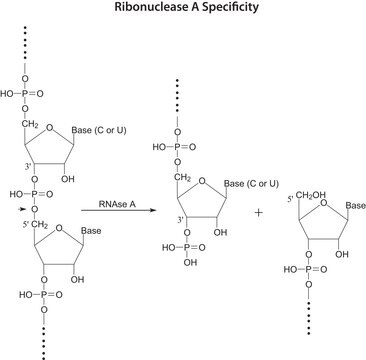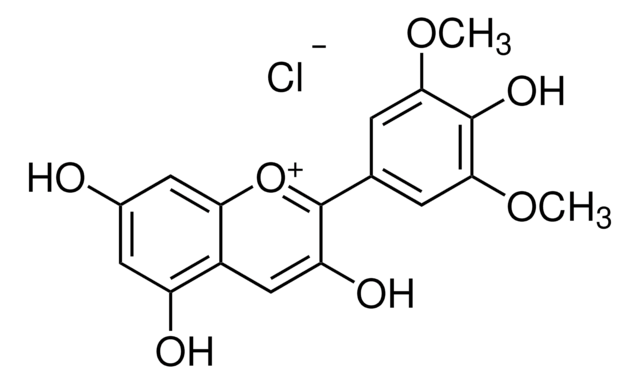HTS071M
ChemiSCREEN Membrane Preparation Recombinant Human ChemR23 Chemoattractant Receptor
Human ChemR23 / CMKLR1 GPCR membrane preparation for Radioligand binding Assays & GTPγS binding.
Faça loginpara ver os preços organizacionais e de contrato
About This Item
Código UNSPSC:
41106514
eCl@ss:
32161000
NACRES:
NA.84
Produtos recomendados
fonte biológica
human
Nível de qualidade
recombinante
expressed in Chem-1 cells
fabricante/nome comercial
ChemiScreen
Chemicon®
técnica(s)
ligand binding assay: suitable (GTPγS)
radioligand binding assay (RLBA): suitable
nº de adesão NCBI
nº de adesão UniProt
Condições de expedição
dry ice
Descrição geral
ChemR23 was discovered as an orphan receptor related to the chemoattractant receptors C3a, C5a and FPR1, and expressed on dendritic cells and macrophages (Samson et al., 1998). A ligand for ChemR23 was characterized as chemerin, a 15 kD proteolytically processed protein found in inflammatory sites; a 9 amino acid peptide from the C-terminus of chemerin is sufficient to activate ChemR23 (Wittamer et al., 2003, 2004). Chemerin expressed in lymphoid and microvascular endothelium mediates migration of ChemR23-expressing dendritic cells to lymphoid organs and vasculature at sites of inflammation (Vermi et al., 2005). In addition, a bioactive lipid, resolvin E1, was found to functionally interact with ChemR23 to reduce inflammation (Arita et al., 2005). Millipore′s ChemR23 membrane preparations are crude membrane preparations made from our proprietary stable recombinant cell lines to ensure high-level of GPCR surface expression; thus, they are ideal HTS tools for screening of ChemR23 interactions with its ligands. The membrane preparations exhibit EC50s of 0.37 nM for chemerin in a GTPγS binding assay.
Full-length human ChemR23
Aplicação
Radioligand binding assay and GTPγS binding.
Ações bioquímicas/fisiológicas
GPCR Class: A
Protein Target: ChemR23 / CMKLR1
Target Sub-Family: Chemoattractant
Qualidade
SPECIFICATIONS: 1 unit = 5 μg
EC50 in GTPγS binding assay by Chemerin: ~ 0.37 nM
EC50 in GTPγS binding assay by Chemerin: ~ 0.37 nM
Especificações
Inucbation Conditions
ASSAY CONDITIONS: Membranes are permeabilized by addition of saponin to an equal concentration by mass, then mixed with [35S]-GTPγS (final concentration of 0.3 nM) in 20 mM HEPES, pH 7.4/100 mM NaCl/10 mM MgCl2/0.5 μM GDP in a nonbinding 96-well plate. Unlabeled chemerin was added to the final concentration indicated in Figure 1 (final volume 100 μL), and incubated for 30 min at 30°C. The binding reaction is transferred to a GF/B filter plate (Millipore MAHF B1H) previously prewetted with water. The plate is washed 3 times (1 mL per well per wash) with cold 10 mM sodium phosphate, pH 7.4, then dried and counted.
One vial contains enough membranes for at least 200 assays (units), where one unit is the amount of membrane that will yield greater than 1000 cpm specific chemerin-stimulated [35S]-GTPγS binding.
The ChemR23 membrane preparation is expected to be functional in a radioligand binding assay; however, the end user will need to determine the optimal radiolabeled ligand for use with this product.
ASSAY CONDITIONS: Membranes are permeabilized by addition of saponin to an equal concentration by mass, then mixed with [35S]-GTPγS (final concentration of 0.3 nM) in 20 mM HEPES, pH 7.4/100 mM NaCl/10 mM MgCl2/0.5 μM GDP in a nonbinding 96-well plate. Unlabeled chemerin was added to the final concentration indicated in Figure 1 (final volume 100 μL), and incubated for 30 min at 30°C. The binding reaction is transferred to a GF/B filter plate (Millipore MAHF B1H) previously prewetted with water. The plate is washed 3 times (1 mL per well per wash) with cold 10 mM sodium phosphate, pH 7.4, then dried and counted.
One vial contains enough membranes for at least 200 assays (units), where one unit is the amount of membrane that will yield greater than 1000 cpm specific chemerin-stimulated [35S]-GTPγS binding.
The ChemR23 membrane preparation is expected to be functional in a radioligand binding assay; however, the end user will need to determine the optimal radiolabeled ligand for use with this product.
forma física
Liquid in packaging buffer: 50 mM Tris pH 7.4, 10% glycerol and 1% BSA no preservatives.
Packaging method: Membranes protein were adjusted to 1 mg/ml in 1 ml packaging buffer, rapidly frozen, and stored at -80°C
Packaging method: Membranes protein were adjusted to 1 mg/ml in 1 ml packaging buffer, rapidly frozen, and stored at -80°C
Armazenamento e estabilidade
Maintain frozen at -70°C for up to 2 years. Do not freeze and thaw.
Informações legais
CHEMICON is a registered trademark of Merck KGaA, Darmstadt, Germany
Exoneração de responsabilidade
Unless otherwise stated in our catalog or other company documentation accompanying the product(s), our products are intended for research use only and are not to be used for any other purpose, which includes but is not limited to, unauthorized commercial uses, in vitro diagnostic uses, ex vivo or in vivo therapeutic uses or any type of consumption or application to humans or animals.
Código de classe de armazenamento
12 - Non Combustible Liquids
Classe de risco de água (WGK)
WGK 2
Certificados de análise (COA)
Busque Certificados de análise (COA) digitando o Número do Lote do produto. Os números de lote e remessa podem ser encontrados no rótulo de um produto após a palavra “Lot” ou “Batch”.
Já possui este produto?
Encontre a documentação dos produtos que você adquiriu recentemente na biblioteca de documentos.
Nossa equipe de cientistas tem experiência em todas as áreas de pesquisa, incluindo Life Sciences, ciência de materiais, síntese química, cromatografia, química analítica e muitas outras.
Entre em contato com a assistência técnica







